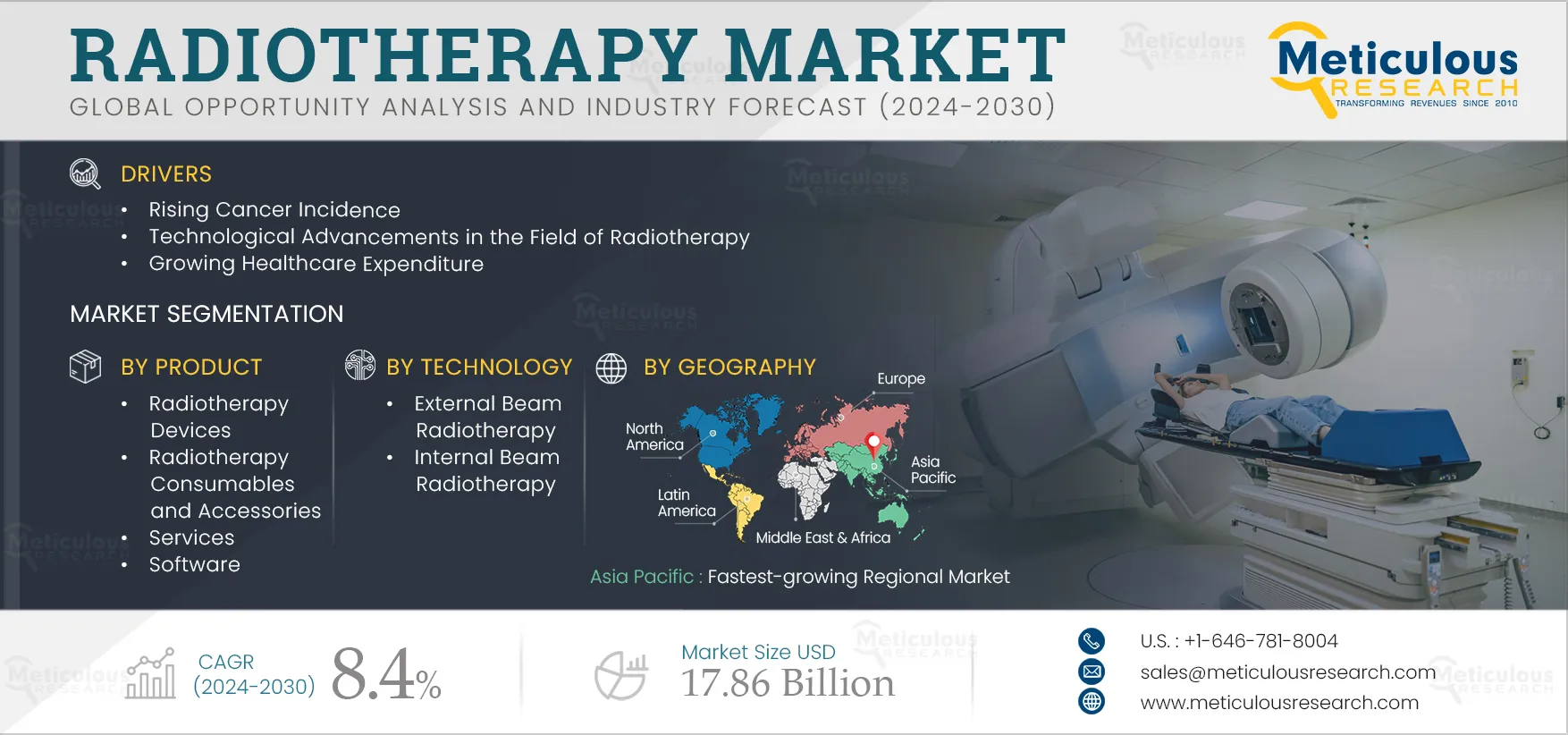The Radiotherapy Market is expected to reach $17.86 billion by 2030, at a CAGR of 8.4% from 2024 to 2030. Radiotherapy is used to treat cancer by radiating the tumor cells and destructing its growth and division procedure. The growth in this market is majorly driven by the growing awareness about the benefits of radiotherapy for cancer treatment, increasing incidence and prevalence of cancer, and technological advancements in the field of radiotherapy. Further, significant opportunities from emerging economies and growing government investments for treatment of cancer are boosting the adoption of radiotherapy.
Here are the top 10 companies operating in the Radiotherapy Market
Varian Medical Systems, Inc. (U.S.)
Incorporated in 1948 and headquartered at California, the U.S.; Varian Medical Systems, Inc. is a manufacturer of medical devices and software for treating cancer and other medical conditions with radiotherapy, stereotactic radiosurgery, stereotactic body radiotherapy, brachytherapy, and proton therapy. The company operates through two business segments, namely oncology systems and proton solutions. The company provides radiotherapy products in both the business segments.
With its subsidiaries and strong network of distribution, the company has its presence in various regions such as North America, Europe, Asia- Pacific, Latin America, and the Middle East & Africa.
Founded in 1972 and headquartered at Stockholm, Sweden. Elekta AB is a medical technology company that aims to provide clinical solutions for treating cancer and brain disorders. The company provides solutions for radiation therapy, radiosurgery for cancer care, image guided radiation therapy, stereotactic radiosurgery to treat tumors, and functional targets with ultra-high precision. The company majorly operates through four regions, namely North and South America, Europe, Asia-Pacific, and the Middle East & Africa.
Accuray Incorporated (U.S.)
Incorporated in 1990 and headquartered at California, the U.S.; Accuray Incorporated is engaged in developing and manufacturing of radiotherapy systems for the treatment of oncology. The company offers radiation therapy technologies, which includes CyberKnife, TomoTherapy, and Radixact System, which are designed to deliver advanced treatments, including Stereotactic Radiosurgery (SRS), Stereotactic Body Radiation Therapy (SBRT), intensity Modulated Radiation Therapy (IMRT), Image Guided Radiation Therapy (IGRT), and adaptive radiation therapy.
With its subsidiaries and strong network of distribution, the company has its presence in various regions such as Americas, Europe, Asia-Pacific, and the Middle East & Africa.
Mevion Medical Systems, Inc. (U.S.)
Incorporated in 2004 and headquartered at Massachusetts, the U.S.; Mevion Medical Systems, Inc. is a provider of proton therapy systems for use in radiation treatment for cancer patients. The company serves customers, which includes cancer centres, clinicians, and patients worldwide.
With its strong network of distribution, the company has its presence across America, Europe, and Asia-Pacific.
ViewRay, Inc. (U.S.)
Founded in 2004 and headquartered at Ohio, the U.S.; ViewRay, Inc. is involved in the designing, manufacturing, and marketing of radiation therapy systems. The company operates through one business segment and provides MRIdian system, which integrates radiation therapy with Magnetic Resonance Imaging (MRI) to simultaneously image and treat cancer patients.
With its subsidiaries and strong network of distribution, the company has its presence predominantly in the U.S., and Europe.
Isoray, Inc. (U.S.)
Incorporated in 1983 and headquartered at Washington, the U.S.; Isoray, Inc. is engaged in designing, development, manufacturing, and sales of personalized brachytherapy products for cancer treatment. The company operates through two business segments, namely prostrate brachytherapy and other brachytherapy. The company provides radiotherapy products through both business segments.
With its subsidiaries and strong network of distribution, the company has its presence in the U.S. only.
Hitachi, Ltd. (Japan)
Founded in 1910 and headquartered at Tokyo, Japan. Hitachi, Ltd. is a provider of IT, infrastructure, electronic equipment, construction machinery, functional components, automotive systems products, and services globally. The company operates through seven business segments, namely information & telecommunication systems, social infrastructure & industrial systems, electronic systems & equipment, construction machinery, high functional materials & components, automotive systems, and smart life & eco-friendly systems. The company provides radiotherapy products in electronic systems and equipment business segment.
With its subsidiaries and strong network of distribution, the company has its presence across North America, Europe, Asia-Pacific, and the Middle East & Africa.
C. R. Bard, Inc. (U.S.)
Founded in 1907 and headquartered at New Jersey, the U.S.; C. R. Bard, Inc. is a developer, manufacturer, and marketer of vascular, urology, oncology, and surgical products. The company focuses on the development of single-patient-use medical products for hospital procedures and is dedicated to pursuing technological innovations to offer superior clinical benefits while helping to reduce overall health care costs. The company markets its products and services worldwide to hospitals, individual health care professionals, extended care facilities, and alternate site facilities. The company provides radiotherapy products under the segment BD Interventional.
With its subsidiaries and strong network of distribution, the company has its presence in North America, Europe, Asia-Pacific, Latin America, and the Middle East & Africa.
Panacea Medical Technologies Pvt. Ltd. (India)
Founded in 1999 and headquartered at Bangalore, India. Panacea Medical Technologies Pvt. Ltd. is a technology-based company and a manufacturer of medical equipment for the diagnosis and treatment of cancer. The company offers products related to radiotherapy which includes Bhabhatron II, Siddharth II, Bhabhatron 3i, Imagin, and for radiology including Lilac for digital mammography and tomosynthesis.
With its strong distribution of network, the company provides its products to South & South-East Asia, and East & West Africa.
Optivus Proton Therapy, Inc. (U.S.)
Founded in 1993 and headquartered at California, the U.S.; Optivus Proton Therapy, Inc. is a developer of proton therapy systems used in the treatment of various types of cancers, some benign conditions, and other diseases.
With its strong network of distribution, the company has its presence in the U.S.
Popular Mentions – P-Cure, Ltd. (Israel), Provison Healthcare, LLC (U.S.), Ion Beam Applications S.A. (Belgium), Theragenics Corporation (U.S.), and Sumitomo Heavy Industries, Ltd. (Japan).
























